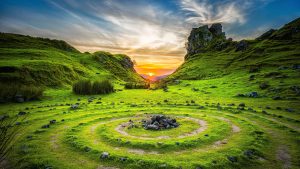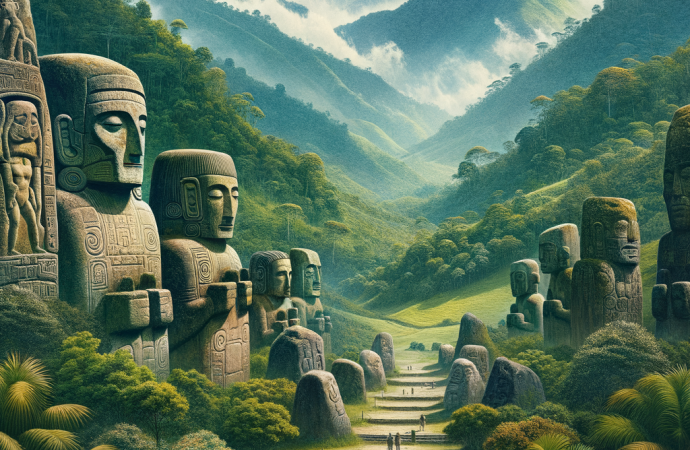Colombia, a country known for its rich cultural heritage, vibrant cities, and breathtaking landscapes, is often overlooked by travelers in favor of more popular South American destinations. However, those who venture beyond the well-trodden paths are rewarded with an array of hidden gems that showcase the country’s diverse beauty and unique charm. In this article,
Colombia, a country known for its rich cultural heritage, vibrant cities, and breathtaking landscapes, is often overlooked by travelers in favor of more popular South American destinations. However, those who venture beyond the well-trodden paths are rewarded with an array of hidden gems that showcase the country’s diverse beauty and unique charm. In this article, we delve into some of Colombia’s lesser-known yet must-visit spots, offering a comprehensive guide for your next trip to this enchanting nation.
San Agustín Archaeological Park
Nestled in the lush mountains of the Huila Department, San Agustín Archaeological Park is a UNESCO World Heritage site that offers a glimpse into Colombia’s pre-Columbian history. The park is home to the largest collection of religious monuments and megalithic sculptures in South America, dating back to the 1st to 8th centuries AD. Visitors can explore the enigmatic statues, tombs, and ceremonial sites that reflect the artistic and spiritual traditions of the ancient San Agustín culture

Image by yandex.com
Caño Cristales
Often referred to as the “River of Five Colors,” Caño Cristales is a natural wonder located in the Serranía de la Macarena National Park. From June to November, the river transforms into a vibrant tapestry of red, yellow, green, blue, and black hues, thanks to the blooming aquatic plants. This stunning phenomenon, combined with the surrounding waterfalls and rock formations, makes Caño Crystals a must-visit destination for nature enthusiasts and photographers alike., a picturesque colonial town in the Santander Department, is often hailed as one of the most beautiful villages in Colombia. With its cobblestone streets, whitewashed houses, and terracotta roofs, Barichara exudes a timeless charm that transports visitors back to the 18th century. The town is also a hub for artisans and craftsmen, offering a variety of handmade goods and traditional crafts. Nearby, the Camino Real, an ancient stone path, provides a scenic hiking route to the equally charming village of Guane.
Tatacoa Desert
The Tatacoa Desert, located in the Huila Department, is a strikingly unique landscape characterized by its eroded rock formations, dry canyons, and vibrant red and gray hues. Despite its name, Tatacoa is technically a tropical dry forest, and it offers a stark contrast to Colombia’s lush rainforests and verdant mountains. The desert is also a prime location for stargazing, with its clear skies providing an unobstructed view of the Milky Way and other celestial wonders.
Providencia Island
For those seeking a tropical paradise off the beaten path, Providencia Island is a hidden gem in the Caribbean Sea. Part of the San Andrés and Providencia archipelago, this idyllic island boasts pristine white-sand beaches, crystal-clear waters, and vibrant coral reefs. Providencia’s laid-back atmosphere and friendly locals make it an ideal destination for relaxation and adventure. Snorkeling, diving, and exploring the island’s lush interior are just a few of the activities that await visitors.
Mompox
Santa Cruz de Mompox, commonly known as Mompox, is a colonial town situated on the banks of the Magdalena River. This UNESCO World Heritage site played a significant role in Colombia’s history, particularly during the Spanish colonization and the fight for independence. Mompox’s well-preserved architecture, including its churches, plazas, and colonial mansions, offers a glimpse into the past. The town is also renowned for its traditional filigree jewelry, a craft that has been passed down through generations.
La Guajira Peninsula
The La Guajira Peninsula, located in the northeastern part of Colombia, is a remote and rugged region that offers a unique blend of desert landscapes, pristine beaches, and indigenous culture. The Wayuu people, who inhabit the peninsula, have preserved their traditional way of life and offer visitors an opportunity to learn about their customs and traditions. Key attractions in La Guajira include the stunning Punta Gallinas, the northernmost point of South America, and the ethereal Tarea Dunes, where the desert meets the Caribbean Sea.

Image by yandex.com
Valle de Cocoran
The Valle de Cocoran, located in the Quindío Department, is a verdant valley that forms part of the Los Nevados National Natural Park. The valley is famous for its towering wax palm trees, which can reach heights of up to 60 meters and are the national tree of Colombia. Hiking through the Valle de Cocoran offers breathtaking views of the Andean landscape, and visitors can also explore the nearby town of Salento, known for its colorful architecture and coffee culture. Vibrant town in the Antioquia Department, is renowned for its colorful zócalos (decorative baseboards) that adorn the facades of its buildings. Each zócalo tells a story, depicting scenes from local life, folklore, and nature. The town is also home to the iconic El Peñol Rock, a massive granite monolith that offers panoramic views of the surrounding lakes and countryside. Climbing the 740 steps to the summit is a rewarding experience that should not be missed.Colombia is increasingly focusing on sustainable travel and eco-tourism. Numerous eco-lodges and sustainable tours are available, allowing you to explore the country’s natural beauty while minimizing your environmental impact. Visit the Sierra Nevada de Santa Marta, a biodiversity hotspot, or the Tayrona National Park, where lush forests meet the Caribbean Sea.
Tierradentro
Tierradentro, located in the Cauca Department, is another UNESCO World Heritage site that offers insight into Colombia’s ancient civilizations. The site is known for its elaborate underground tombs, which date back to the 6th to 9th centuries AD. These tombs, adorned with intricate carvings and paintings, provide a fascinating glimpse into the funerary practices and beliefs of the indigenous Tierradentro culture. The surrounding landscape, characterized by rolling hills and lush valleys, adds to the site’s allure.
Conclusion
Colombia’s hidden gems offer a diverse array of experiences that cater to all types of travelers. From archaeological wonders and colonial towns to natural landscapes and vibrant cultures, these must-visit spots provide a deeper understanding of the country’s rich heritage and natural beauty. As you plan your next trip, consider venturing off the beaten path to discover the enchanting destinations that make Colombia a truly unique and unforgettable destination.
















